HNN215: Case Study Analysis: Quality Use of Medicines in Healthcare
VerifiedAdded on 2021/08/10
|8
|2435
|73
Case Study
AI Summary
This case study, completed for HNN215, analyzes the medication regime of Mr. Coleman, identifying significant risks such as hypotension and haemorrhage associated with his anti-hypertensive and antiplatelet medications. It explores nursing strategies to prevent and manage these risks, including monitoring vital signs, falls risk assessments, and patient education. The assignment also examines factors contributing to Mr. Coleman's decreased adherence to his medication regimen, such as poor health literacy and adverse effects. Furthermore, it outlines key educational points for nurses to provide regarding atorvastatin, including its purpose, potential side effects, and crucial interactions like avoiding grapefruit juice. The paper references several medical journals and textbooks to support its findings and recommendations. The assignment provides a comprehensive overview of medication management and patient care within a healthcare setting.

HNN215 Quality use of Medicines
Assessment Task 1 Case Study
Word Count: 1400
Hannah Emerson
219164429
Assessment Task 1 Case Study
Word Count: 1400
Hannah Emerson
219164429
Paraphrase This Document
Need a fresh take? Get an instant paraphrase of this document with our AI Paraphraser
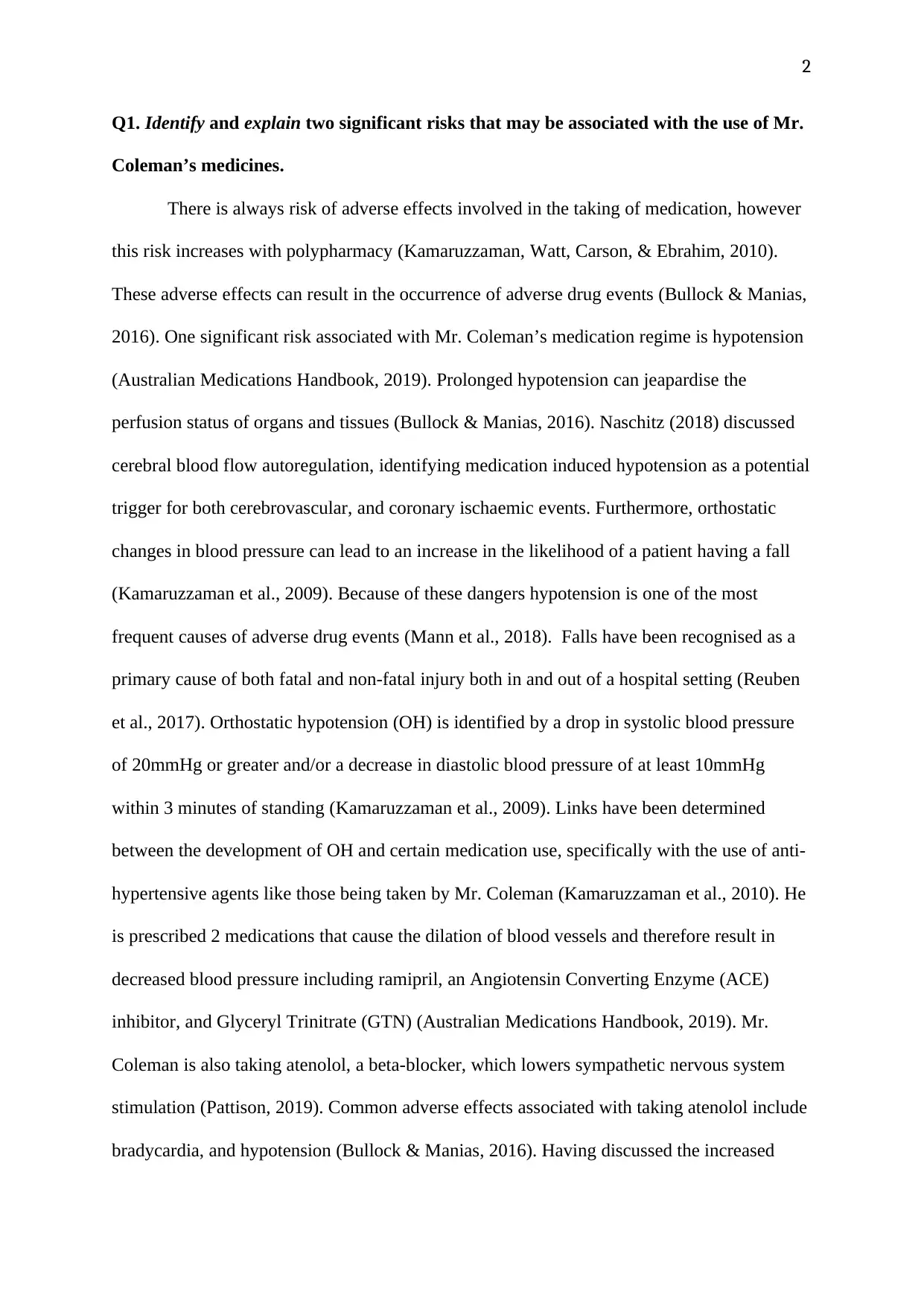
Q1. Identify and explain two significant risks that may be associated with the use of Mr.
Coleman’s medicines.
There is always risk of adverse effects involved in the taking of medication, however
this risk increases with polypharmacy (Kamaruzzaman, Watt, Carson, & Ebrahim, 2010).
These adverse effects can result in the occurrence of adverse drug events (Bullock & Manias,
2016). One significant risk associated with Mr. Coleman’s medication regime is hypotension
(Australian Medications Handbook, 2019). Prolonged hypotension can jeapardise the
perfusion status of organs and tissues (Bullock & Manias, 2016). Naschitz (2018) discussed
cerebral blood flow autoregulation, identifying medication induced hypotension as a potential
trigger for both cerebrovascular, and coronary ischaemic events. Furthermore, orthostatic
changes in blood pressure can lead to an increase in the likelihood of a patient having a fall
(Kamaruzzaman et al., 2009). Because of these dangers hypotension is one of the most
frequent causes of adverse drug events (Mann et al., 2018). Falls have been recognised as a
primary cause of both fatal and non-fatal injury both in and out of a hospital setting (Reuben
et al., 2017). Orthostatic hypotension (OH) is identified by a drop in systolic blood pressure
of 20mmHg or greater and/or a decrease in diastolic blood pressure of at least 10mmHg
within 3 minutes of standing (Kamaruzzaman et al., 2009). Links have been determined
between the development of OH and certain medication use, specifically with the use of anti-
hypertensive agents like those being taken by Mr. Coleman (Kamaruzzaman et al., 2010). He
is prescribed 2 medications that cause the dilation of blood vessels and therefore result in
decreased blood pressure including ramipril, an Angiotensin Converting Enzyme (ACE)
inhibitor, and Glyceryl Trinitrate (GTN) (Australian Medications Handbook, 2019). Mr.
Coleman is also taking atenolol, a beta-blocker, which lowers sympathetic nervous system
stimulation (Pattison, 2019). Common adverse effects associated with taking atenolol include
bradycardia, and hypotension (Bullock & Manias, 2016). Having discussed the increased
2
Coleman’s medicines.
There is always risk of adverse effects involved in the taking of medication, however
this risk increases with polypharmacy (Kamaruzzaman, Watt, Carson, & Ebrahim, 2010).
These adverse effects can result in the occurrence of adverse drug events (Bullock & Manias,
2016). One significant risk associated with Mr. Coleman’s medication regime is hypotension
(Australian Medications Handbook, 2019). Prolonged hypotension can jeapardise the
perfusion status of organs and tissues (Bullock & Manias, 2016). Naschitz (2018) discussed
cerebral blood flow autoregulation, identifying medication induced hypotension as a potential
trigger for both cerebrovascular, and coronary ischaemic events. Furthermore, orthostatic
changes in blood pressure can lead to an increase in the likelihood of a patient having a fall
(Kamaruzzaman et al., 2009). Because of these dangers hypotension is one of the most
frequent causes of adverse drug events (Mann et al., 2018). Falls have been recognised as a
primary cause of both fatal and non-fatal injury both in and out of a hospital setting (Reuben
et al., 2017). Orthostatic hypotension (OH) is identified by a drop in systolic blood pressure
of 20mmHg or greater and/or a decrease in diastolic blood pressure of at least 10mmHg
within 3 minutes of standing (Kamaruzzaman et al., 2009). Links have been determined
between the development of OH and certain medication use, specifically with the use of anti-
hypertensive agents like those being taken by Mr. Coleman (Kamaruzzaman et al., 2010). He
is prescribed 2 medications that cause the dilation of blood vessels and therefore result in
decreased blood pressure including ramipril, an Angiotensin Converting Enzyme (ACE)
inhibitor, and Glyceryl Trinitrate (GTN) (Australian Medications Handbook, 2019). Mr.
Coleman is also taking atenolol, a beta-blocker, which lowers sympathetic nervous system
stimulation (Pattison, 2019). Common adverse effects associated with taking atenolol include
bradycardia, and hypotension (Bullock & Manias, 2016). Having discussed the increased
2

likelihood of Mr. Coleman experiencing a fall due to hypotension leads us to our second
significant risk associated with his medications, that being haemorrhage (Bullock & Manias,
2016). Mr. Coleman has been prescribed three antiplatelet medications that are responsible
for inhibiting platelet aggregation, an essential component of the clotting cascade (Bullock &
Manias, 2016; Berman et al., 2015). They are predominantly used in the treatment and
prevention of potentially life threatening thromboembolic diseases (Ganetsky et al., 2017).
However, the benefits of antiplatelet medications are accompanied by the fact that their use
increases the chances of sustaining a traumatic intracranial haemorrhage (Genetsky et al.,
2017). They will also increase the severity of an intracranial haemorrhage caused by even
minor trauma, such as a low velocity fall from standing height (Ganetsky et al., 2017). Two
of Mr. Coleman’s antiplatelet medications, clopidogrel and aspirin, irreversibly bind to the
platelets, their effects lasting for the lifetime of the platelet itself (Australian Medications
Handbook, 2019).
Q2. Describe the strategies a nurse may implement to prevent/manage these risks.
Mr. Coleman’s nursing staff will be able to implement a variety of strategies to avoid,
and manage the risks previously outlined. It is important for a hypotensive patient to be
informed about the need to minimise impulsive postural changes (Berman et al., 2015;
Australian Medications Handbook, 2019). Instruct them to rise slowly when going from lying
to sitting positions, before standing and staying stationary for several seconds to allow
themselves to adjust (Berman et al., 2015). The use of balance assisting equipment should be
encouraged where appropriate (Lee et al., 2017). Examples of these may include walking
aids, and the use of grip bars if they are available (Lee et al., 2017). They should undertake a
falls risk assessment of Mr. Coleman to help inform by identifying areas of concern (Berman
et al., 2015). If deemed necessary, nursing staff may request that their patient make sure they
3
significant risk associated with his medications, that being haemorrhage (Bullock & Manias,
2016). Mr. Coleman has been prescribed three antiplatelet medications that are responsible
for inhibiting platelet aggregation, an essential component of the clotting cascade (Bullock &
Manias, 2016; Berman et al., 2015). They are predominantly used in the treatment and
prevention of potentially life threatening thromboembolic diseases (Ganetsky et al., 2017).
However, the benefits of antiplatelet medications are accompanied by the fact that their use
increases the chances of sustaining a traumatic intracranial haemorrhage (Genetsky et al.,
2017). They will also increase the severity of an intracranial haemorrhage caused by even
minor trauma, such as a low velocity fall from standing height (Ganetsky et al., 2017). Two
of Mr. Coleman’s antiplatelet medications, clopidogrel and aspirin, irreversibly bind to the
platelets, their effects lasting for the lifetime of the platelet itself (Australian Medications
Handbook, 2019).
Q2. Describe the strategies a nurse may implement to prevent/manage these risks.
Mr. Coleman’s nursing staff will be able to implement a variety of strategies to avoid,
and manage the risks previously outlined. It is important for a hypotensive patient to be
informed about the need to minimise impulsive postural changes (Berman et al., 2015;
Australian Medications Handbook, 2019). Instruct them to rise slowly when going from lying
to sitting positions, before standing and staying stationary for several seconds to allow
themselves to adjust (Berman et al., 2015). The use of balance assisting equipment should be
encouraged where appropriate (Lee et al., 2017). Examples of these may include walking
aids, and the use of grip bars if they are available (Lee et al., 2017). They should undertake a
falls risk assessment of Mr. Coleman to help inform by identifying areas of concern (Berman
et al., 2015). If deemed necessary, nursing staff may request that their patient make sure they
3
⊘ This is a preview!⊘
Do you want full access?
Subscribe today to unlock all pages.

Trusted by 1+ million students worldwide
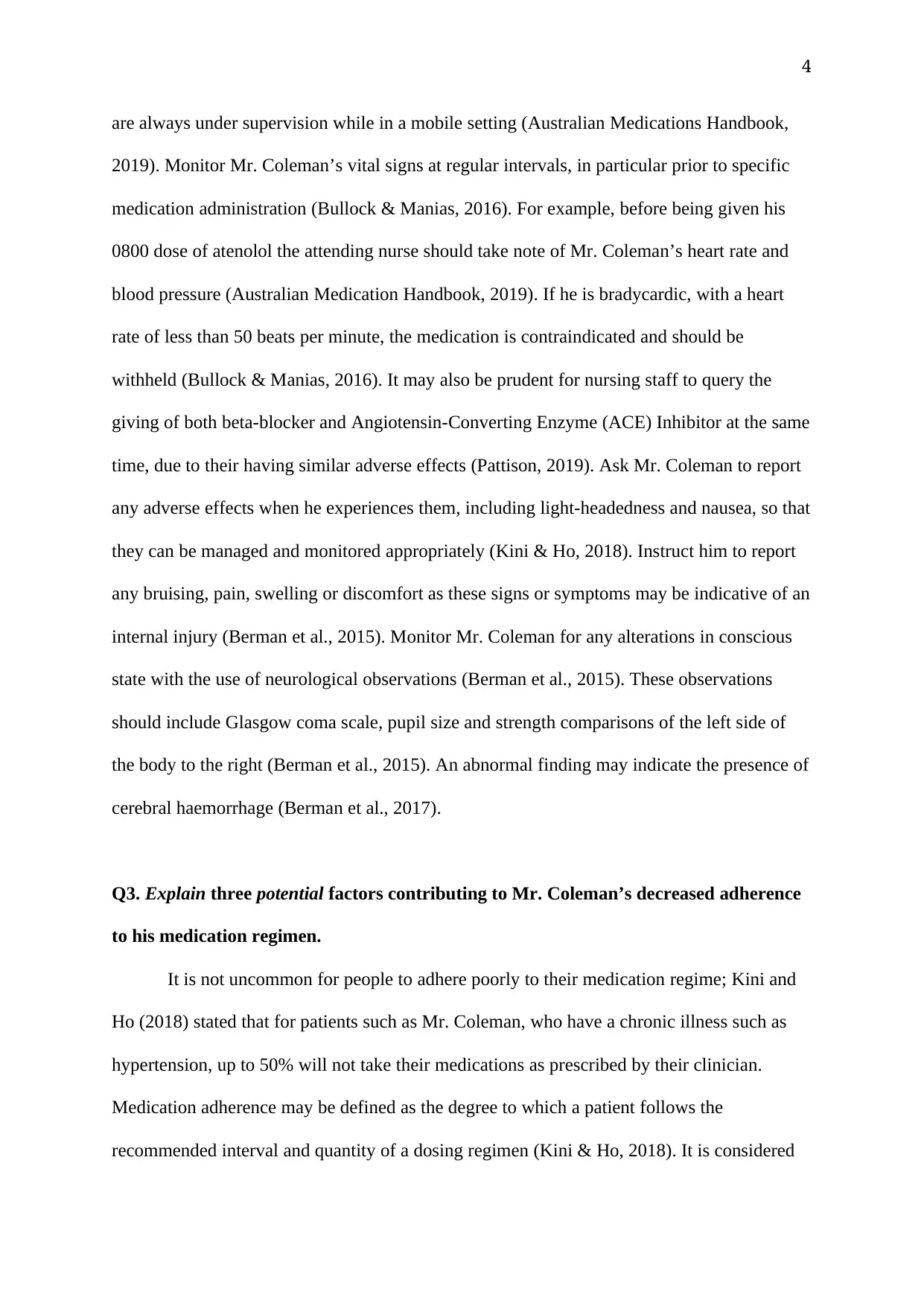
are always under supervision while in a mobile setting (Australian Medications Handbook,
2019). Monitor Mr. Coleman’s vital signs at regular intervals, in particular prior to specific
medication administration (Bullock & Manias, 2016). For example, before being given his
0800 dose of atenolol the attending nurse should take note of Mr. Coleman’s heart rate and
blood pressure (Australian Medication Handbook, 2019). If he is bradycardic, with a heart
rate of less than 50 beats per minute, the medication is contraindicated and should be
withheld (Bullock & Manias, 2016). It may also be prudent for nursing staff to query the
giving of both beta-blocker and Angiotensin-Converting Enzyme (ACE) Inhibitor at the same
time, due to their having similar adverse effects (Pattison, 2019). Ask Mr. Coleman to report
any adverse effects when he experiences them, including light-headedness and nausea, so that
they can be managed and monitored appropriately (Kini & Ho, 2018). Instruct him to report
any bruising, pain, swelling or discomfort as these signs or symptoms may be indicative of an
internal injury (Berman et al., 2015). Monitor Mr. Coleman for any alterations in conscious
state with the use of neurological observations (Berman et al., 2015). These observations
should include Glasgow coma scale, pupil size and strength comparisons of the left side of
the body to the right (Berman et al., 2015). An abnormal finding may indicate the presence of
cerebral haemorrhage (Berman et al., 2017).
Q3. Explain three potential factors contributing to Mr. Coleman’s decreased adherence
to his medication regimen.
It is not uncommon for people to adhere poorly to their medication regime; Kini and
Ho (2018) stated that for patients such as Mr. Coleman, who have a chronic illness such as
hypertension, up to 50% will not take their medications as prescribed by their clinician.
Medication adherence may be defined as the degree to which a patient follows the
recommended interval and quantity of a dosing regimen (Kini & Ho, 2018). It is considered
4
2019). Monitor Mr. Coleman’s vital signs at regular intervals, in particular prior to specific
medication administration (Bullock & Manias, 2016). For example, before being given his
0800 dose of atenolol the attending nurse should take note of Mr. Coleman’s heart rate and
blood pressure (Australian Medication Handbook, 2019). If he is bradycardic, with a heart
rate of less than 50 beats per minute, the medication is contraindicated and should be
withheld (Bullock & Manias, 2016). It may also be prudent for nursing staff to query the
giving of both beta-blocker and Angiotensin-Converting Enzyme (ACE) Inhibitor at the same
time, due to their having similar adverse effects (Pattison, 2019). Ask Mr. Coleman to report
any adverse effects when he experiences them, including light-headedness and nausea, so that
they can be managed and monitored appropriately (Kini & Ho, 2018). Instruct him to report
any bruising, pain, swelling or discomfort as these signs or symptoms may be indicative of an
internal injury (Berman et al., 2015). Monitor Mr. Coleman for any alterations in conscious
state with the use of neurological observations (Berman et al., 2015). These observations
should include Glasgow coma scale, pupil size and strength comparisons of the left side of
the body to the right (Berman et al., 2015). An abnormal finding may indicate the presence of
cerebral haemorrhage (Berman et al., 2017).
Q3. Explain three potential factors contributing to Mr. Coleman’s decreased adherence
to his medication regimen.
It is not uncommon for people to adhere poorly to their medication regime; Kini and
Ho (2018) stated that for patients such as Mr. Coleman, who have a chronic illness such as
hypertension, up to 50% will not take their medications as prescribed by their clinician.
Medication adherence may be defined as the degree to which a patient follows the
recommended interval and quantity of a dosing regimen (Kini & Ho, 2018). It is considered
4
Paraphrase This Document
Need a fresh take? Get an instant paraphrase of this document with our AI Paraphraser
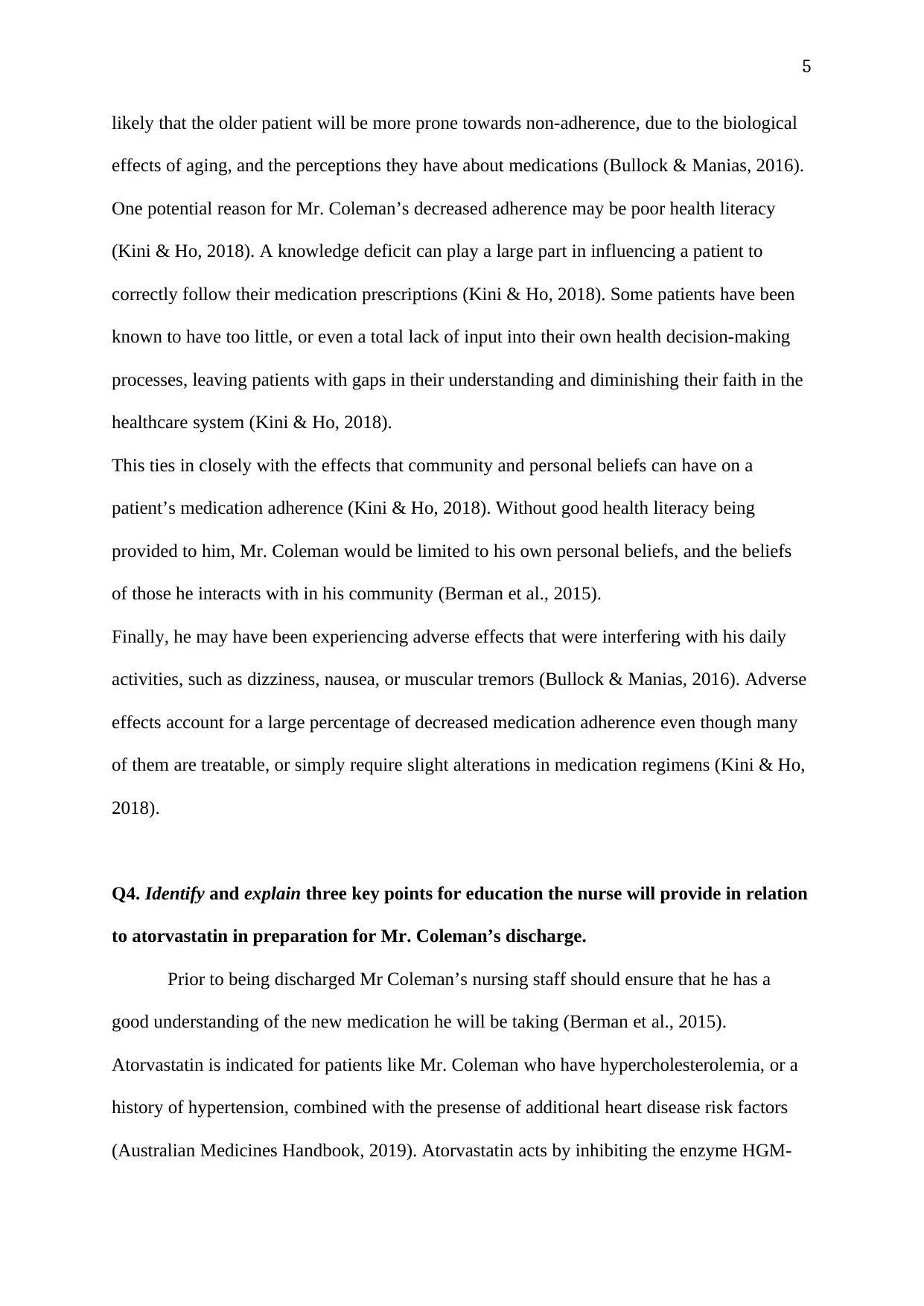
likely that the older patient will be more prone towards non-adherence, due to the biological
effects of aging, and the perceptions they have about medications (Bullock & Manias, 2016).
One potential reason for Mr. Coleman’s decreased adherence may be poor health literacy
(Kini & Ho, 2018). A knowledge deficit can play a large part in influencing a patient to
correctly follow their medication prescriptions (Kini & Ho, 2018). Some patients have been
known to have too little, or even a total lack of input into their own health decision-making
processes, leaving patients with gaps in their understanding and diminishing their faith in the
healthcare system (Kini & Ho, 2018).
This ties in closely with the effects that community and personal beliefs can have on a
patient’s medication adherence (Kini & Ho, 2018). Without good health literacy being
provided to him, Mr. Coleman would be limited to his own personal beliefs, and the beliefs
of those he interacts with in his community (Berman et al., 2015).
Finally, he may have been experiencing adverse effects that were interfering with his daily
activities, such as dizziness, nausea, or muscular tremors (Bullock & Manias, 2016). Adverse
effects account for a large percentage of decreased medication adherence even though many
of them are treatable, or simply require slight alterations in medication regimens (Kini & Ho,
2018).
Q4. Identify and explain three key points for education the nurse will provide in relation
to atorvastatin in preparation for Mr. Coleman’s discharge.
Prior to being discharged Mr Coleman’s nursing staff should ensure that he has a
good understanding of the new medication he will be taking (Berman et al., 2015).
Atorvastatin is indicated for patients like Mr. Coleman who have hypercholesterolemia, or a
history of hypertension, combined with the presense of additional heart disease risk factors
(Australian Medicines Handbook, 2019). Atorvastatin acts by inhibiting the enzyme HGM-
5
effects of aging, and the perceptions they have about medications (Bullock & Manias, 2016).
One potential reason for Mr. Coleman’s decreased adherence may be poor health literacy
(Kini & Ho, 2018). A knowledge deficit can play a large part in influencing a patient to
correctly follow their medication prescriptions (Kini & Ho, 2018). Some patients have been
known to have too little, or even a total lack of input into their own health decision-making
processes, leaving patients with gaps in their understanding and diminishing their faith in the
healthcare system (Kini & Ho, 2018).
This ties in closely with the effects that community and personal beliefs can have on a
patient’s medication adherence (Kini & Ho, 2018). Without good health literacy being
provided to him, Mr. Coleman would be limited to his own personal beliefs, and the beliefs
of those he interacts with in his community (Berman et al., 2015).
Finally, he may have been experiencing adverse effects that were interfering with his daily
activities, such as dizziness, nausea, or muscular tremors (Bullock & Manias, 2016). Adverse
effects account for a large percentage of decreased medication adherence even though many
of them are treatable, or simply require slight alterations in medication regimens (Kini & Ho,
2018).
Q4. Identify and explain three key points for education the nurse will provide in relation
to atorvastatin in preparation for Mr. Coleman’s discharge.
Prior to being discharged Mr Coleman’s nursing staff should ensure that he has a
good understanding of the new medication he will be taking (Berman et al., 2015).
Atorvastatin is indicated for patients like Mr. Coleman who have hypercholesterolemia, or a
history of hypertension, combined with the presense of additional heart disease risk factors
(Australian Medicines Handbook, 2019). Atorvastatin acts by inhibiting the enzyme HGM-
5
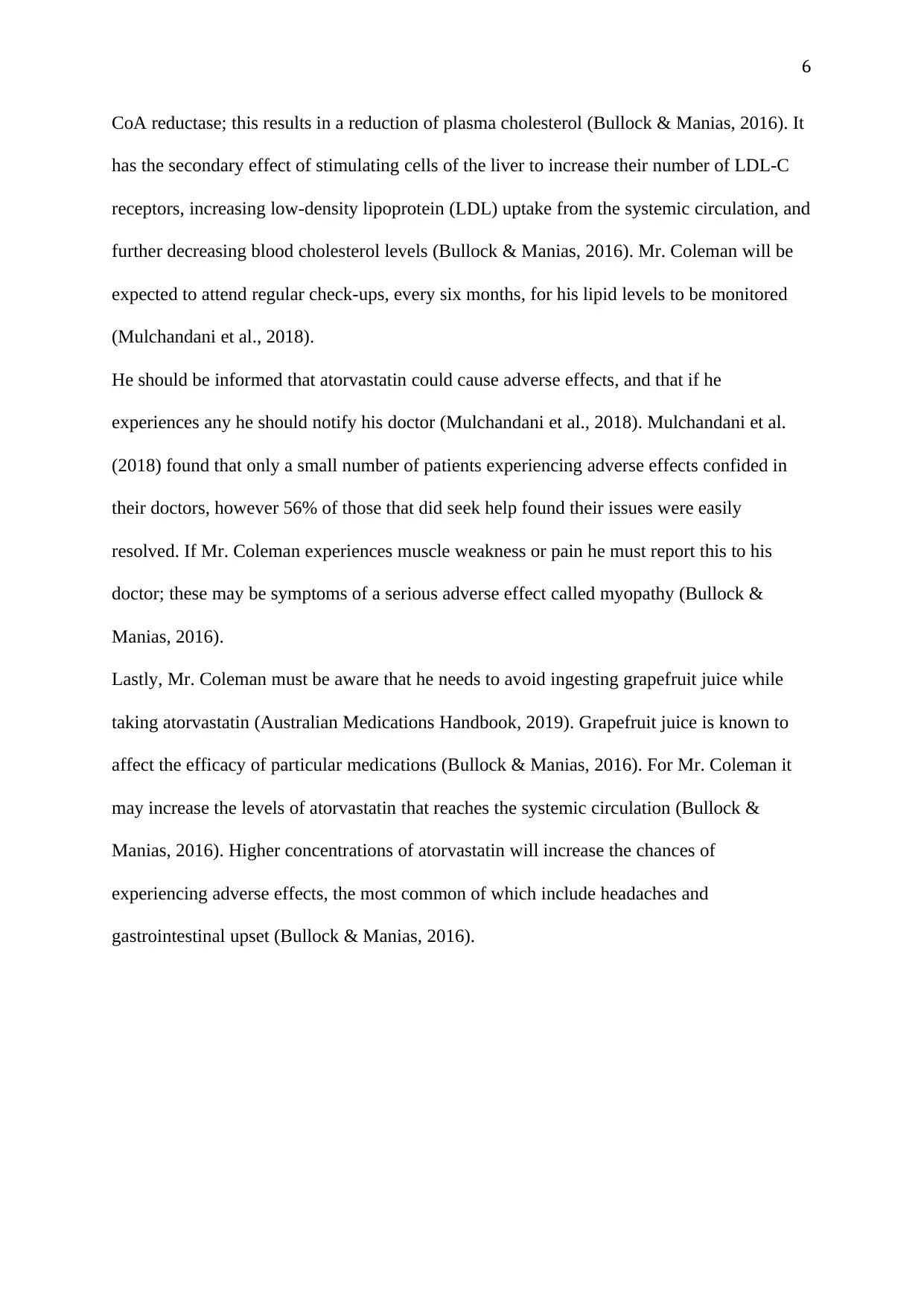
CoA reductase; this results in a reduction of plasma cholesterol (Bullock & Manias, 2016). It
has the secondary effect of stimulating cells of the liver to increase their number of LDL-C
receptors, increasing low-density lipoprotein (LDL) uptake from the systemic circulation, and
further decreasing blood cholesterol levels (Bullock & Manias, 2016). Mr. Coleman will be
expected to attend regular check-ups, every six months, for his lipid levels to be monitored
(Mulchandani et al., 2018).
He should be informed that atorvastatin could cause adverse effects, and that if he
experiences any he should notify his doctor (Mulchandani et al., 2018). Mulchandani et al.
(2018) found that only a small number of patients experiencing adverse effects confided in
their doctors, however 56% of those that did seek help found their issues were easily
resolved. If Mr. Coleman experiences muscle weakness or pain he must report this to his
doctor; these may be symptoms of a serious adverse effect called myopathy (Bullock &
Manias, 2016).
Lastly, Mr. Coleman must be aware that he needs to avoid ingesting grapefruit juice while
taking atorvastatin (Australian Medications Handbook, 2019). Grapefruit juice is known to
affect the efficacy of particular medications (Bullock & Manias, 2016). For Mr. Coleman it
may increase the levels of atorvastatin that reaches the systemic circulation (Bullock &
Manias, 2016). Higher concentrations of atorvastatin will increase the chances of
experiencing adverse effects, the most common of which include headaches and
gastrointestinal upset (Bullock & Manias, 2016).
6
has the secondary effect of stimulating cells of the liver to increase their number of LDL-C
receptors, increasing low-density lipoprotein (LDL) uptake from the systemic circulation, and
further decreasing blood cholesterol levels (Bullock & Manias, 2016). Mr. Coleman will be
expected to attend regular check-ups, every six months, for his lipid levels to be monitored
(Mulchandani et al., 2018).
He should be informed that atorvastatin could cause adverse effects, and that if he
experiences any he should notify his doctor (Mulchandani et al., 2018). Mulchandani et al.
(2018) found that only a small number of patients experiencing adverse effects confided in
their doctors, however 56% of those that did seek help found their issues were easily
resolved. If Mr. Coleman experiences muscle weakness or pain he must report this to his
doctor; these may be symptoms of a serious adverse effect called myopathy (Bullock &
Manias, 2016).
Lastly, Mr. Coleman must be aware that he needs to avoid ingesting grapefruit juice while
taking atorvastatin (Australian Medications Handbook, 2019). Grapefruit juice is known to
affect the efficacy of particular medications (Bullock & Manias, 2016). For Mr. Coleman it
may increase the levels of atorvastatin that reaches the systemic circulation (Bullock &
Manias, 2016). Higher concentrations of atorvastatin will increase the chances of
experiencing adverse effects, the most common of which include headaches and
gastrointestinal upset (Bullock & Manias, 2016).
6
⊘ This is a preview!⊘
Do you want full access?
Subscribe today to unlock all pages.

Trusted by 1+ million students worldwide

References
Australian Medicines Handbook. (2019). Adelaide: Australian Medicines Handbook Pty Ltd.
Berman, A., Snyder, S. J., Kozier, B., Erb, G. L., Levett-Jones, T., Dwyer, T., … Stanley, D.
(2015). Kozier and Erb’s fundamentals of nursing (3rd ed., vol. 1-3). Melbourne:
Pearson Australia.
Bullock, S., & Manias, E. (2016). Fundamentals of pharmacology (8th ed.). NSW: Pearson
Australia.
Ganetsky, M., Lopez, G., Coreanu, T., Novack, V., Horng, S., Shapiro, N. I., Bauer, K. A.
(2017). Risk of intracranial haemorrhage in ground-level fall with antiplatelet or
anticoagulant agents. Academic Emergency Medicine, 24(10), 1258-1266. doi:
10.1111/acem.13217
Kamaruzzaman, S., Watt, H., Carson, C., & Ebrahim, S. (2010). The association between
orthostatic hypotension and medication use in the British women’s heart and health
study. Age and Aging, 2010(39), 51-56. doi: 10.1093/ageing/afp192
Kini, V., & Ho, M. (2018). Interventions to improve medication adherence: A review.
Journal of the American Medical Association, 320(23), 2461-2473.
doi:10.1001/jama.2018.19271
Lee, S. M., Loo, G., Long, W., Lock, J. Z., Soh, S. Y., Seetharaman, S. K., & Merchant, R.
A. (2017). Risk assessment and falls prevention in the older adult: Asian experience
with the falls risk for older people in the community tool. Geriatrics and Gerontology
International, 17(3), 518-519.
https://doi-org.ezproxy-b.deakin.edu.au/10.1111/ggi.12889
Mann, E., Zepeda, O., Soones T., Federman, A., Leff, B., Siu, A., & Boockvar, K. (2018).
Adverse drug events and medication problems in “hospital at home” patients. Home
7
Australian Medicines Handbook. (2019). Adelaide: Australian Medicines Handbook Pty Ltd.
Berman, A., Snyder, S. J., Kozier, B., Erb, G. L., Levett-Jones, T., Dwyer, T., … Stanley, D.
(2015). Kozier and Erb’s fundamentals of nursing (3rd ed., vol. 1-3). Melbourne:
Pearson Australia.
Bullock, S., & Manias, E. (2016). Fundamentals of pharmacology (8th ed.). NSW: Pearson
Australia.
Ganetsky, M., Lopez, G., Coreanu, T., Novack, V., Horng, S., Shapiro, N. I., Bauer, K. A.
(2017). Risk of intracranial haemorrhage in ground-level fall with antiplatelet or
anticoagulant agents. Academic Emergency Medicine, 24(10), 1258-1266. doi:
10.1111/acem.13217
Kamaruzzaman, S., Watt, H., Carson, C., & Ebrahim, S. (2010). The association between
orthostatic hypotension and medication use in the British women’s heart and health
study. Age and Aging, 2010(39), 51-56. doi: 10.1093/ageing/afp192
Kini, V., & Ho, M. (2018). Interventions to improve medication adherence: A review.
Journal of the American Medical Association, 320(23), 2461-2473.
doi:10.1001/jama.2018.19271
Lee, S. M., Loo, G., Long, W., Lock, J. Z., Soh, S. Y., Seetharaman, S. K., & Merchant, R.
A. (2017). Risk assessment and falls prevention in the older adult: Asian experience
with the falls risk for older people in the community tool. Geriatrics and Gerontology
International, 17(3), 518-519.
https://doi-org.ezproxy-b.deakin.edu.au/10.1111/ggi.12889
Mann, E., Zepeda, O., Soones T., Federman, A., Leff, B., Siu, A., & Boockvar, K. (2018).
Adverse drug events and medication problems in “hospital at home” patients. Home
7
Paraphrase This Document
Need a fresh take? Get an instant paraphrase of this document with our AI Paraphraser
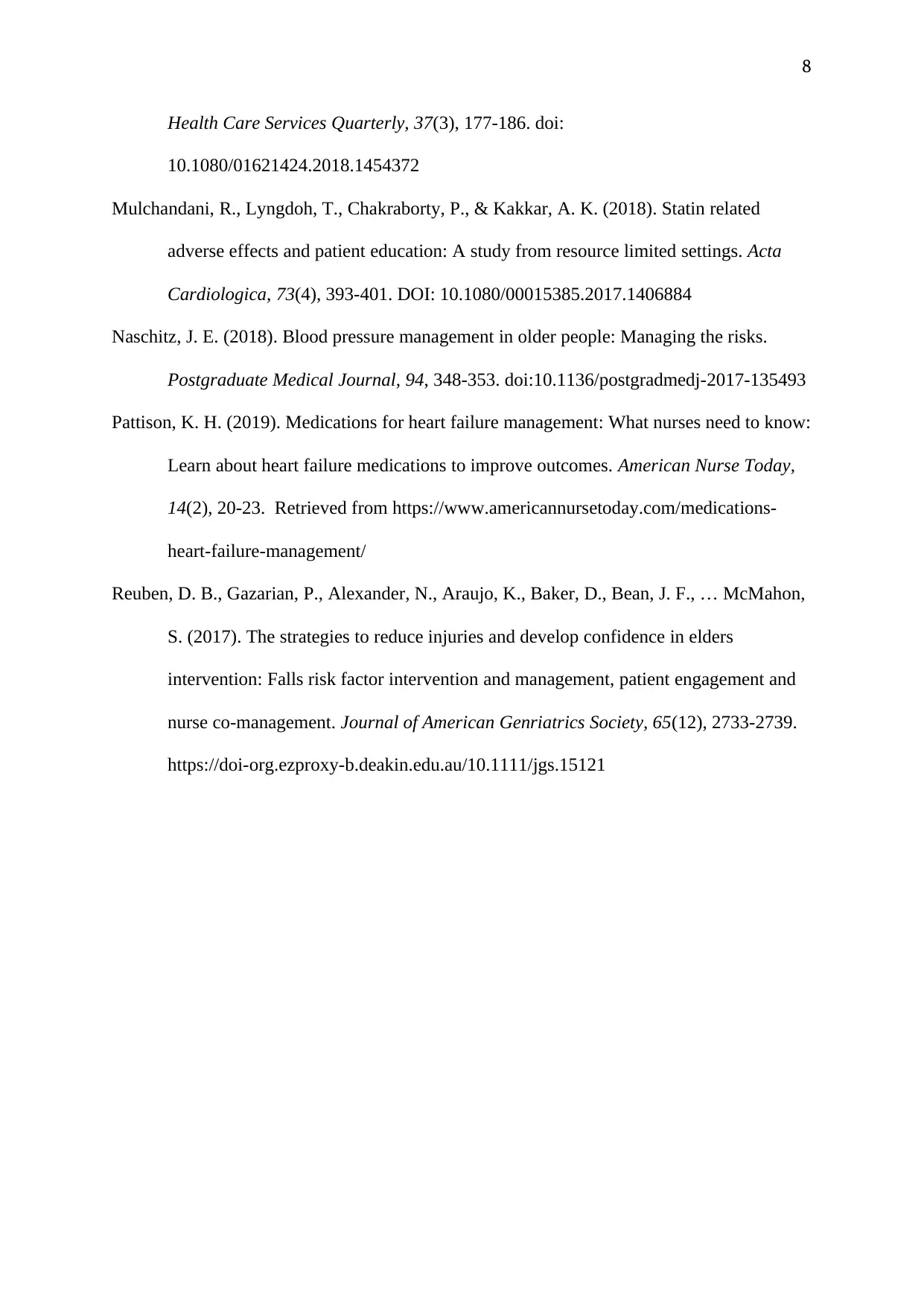
Health Care Services Quarterly, 37(3), 177-186. doi:
10.1080/01621424.2018.1454372
Mulchandani, R., Lyngdoh, T., Chakraborty, P., & Kakkar, A. K. (2018). Statin related
adverse effects and patient education: A study from resource limited settings. Acta
Cardiologica, 73(4), 393-401. DOI: 10.1080/00015385.2017.1406884
Naschitz, J. E. (2018). Blood pressure management in older people: Managing the risks.
Postgraduate Medical Journal, 94, 348-353. doi:10.1136/postgradmedj-2017-135493
Pattison, K. H. (2019). Medications for heart failure management: What nurses need to know:
Learn about heart failure medications to improve outcomes. American Nurse Today,
14(2), 20-23. Retrieved from https://www.americannursetoday.com/medications-
heart-failure-management/
Reuben, D. B., Gazarian, P., Alexander, N., Araujo, K., Baker, D., Bean, J. F., … McMahon,
S. (2017). The strategies to reduce injuries and develop confidence in elders
intervention: Falls risk factor intervention and management, patient engagement and
nurse co-management. Journal of American Genriatrics Society, 65(12), 2733-2739.
https://doi-org.ezproxy-b.deakin.edu.au/10.1111/jgs.15121
8
10.1080/01621424.2018.1454372
Mulchandani, R., Lyngdoh, T., Chakraborty, P., & Kakkar, A. K. (2018). Statin related
adverse effects and patient education: A study from resource limited settings. Acta
Cardiologica, 73(4), 393-401. DOI: 10.1080/00015385.2017.1406884
Naschitz, J. E. (2018). Blood pressure management in older people: Managing the risks.
Postgraduate Medical Journal, 94, 348-353. doi:10.1136/postgradmedj-2017-135493
Pattison, K. H. (2019). Medications for heart failure management: What nurses need to know:
Learn about heart failure medications to improve outcomes. American Nurse Today,
14(2), 20-23. Retrieved from https://www.americannursetoday.com/medications-
heart-failure-management/
Reuben, D. B., Gazarian, P., Alexander, N., Araujo, K., Baker, D., Bean, J. F., … McMahon,
S. (2017). The strategies to reduce injuries and develop confidence in elders
intervention: Falls risk factor intervention and management, patient engagement and
nurse co-management. Journal of American Genriatrics Society, 65(12), 2733-2739.
https://doi-org.ezproxy-b.deakin.edu.au/10.1111/jgs.15121
8
1 out of 8
Your All-in-One AI-Powered Toolkit for Academic Success.
+13062052269
info@desklib.com
Available 24*7 on WhatsApp / Email
![[object Object]](/_next/static/media/star-bottom.7253800d.svg)
Unlock your academic potential
Copyright © 2020–2025 A2Z Services. All Rights Reserved. Developed and managed by ZUCOL.
